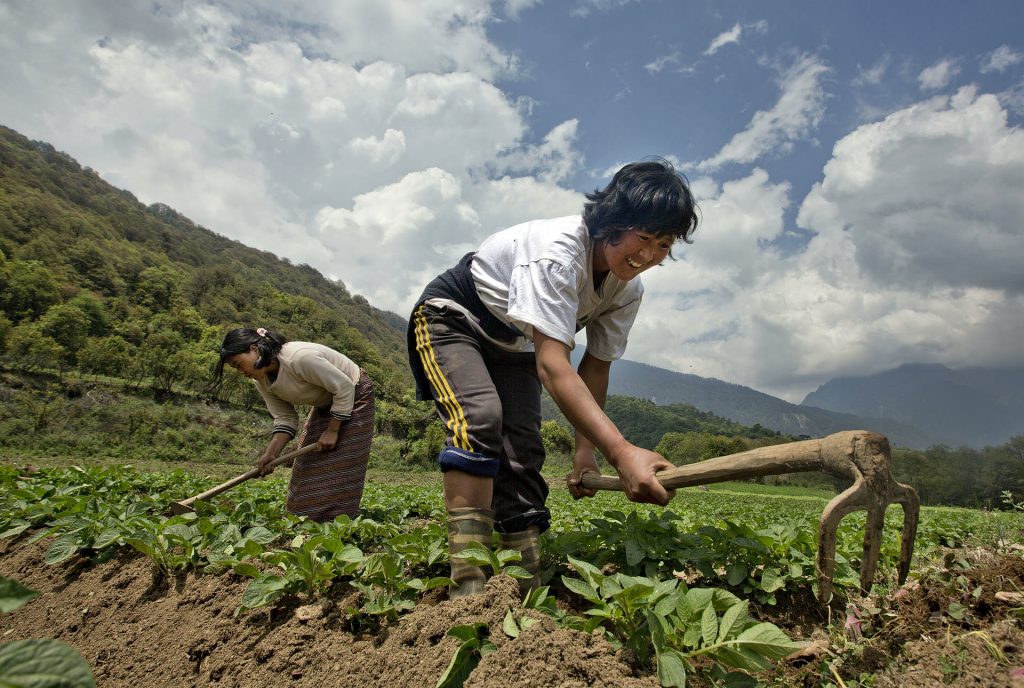Join GlobalBizzNetwork and start your international business network today.
Bhutan

Bhutan is a unique country both culturally and environmentally. Perched high in the Himalayas, it is the world’s last remaining Buddhist Kingdom. It has developed the philosophy of Gross National Happiness; where development is measured using a holistic approach of well-being, not just based on gross domestic product.
It is still termed as a third world country with subsistence farming practised in much of Bhutan. In broad terms the land is fertile and the population small. In addition, the current generation receives free education, and all citizens have access to free, although rudimentary, medical care. The sale of tobacco products is banned and smoking in public areas is an offence punished with fines.
Major sources of income for the kingdom are tourism, hydroelectric power and agriculture. Rice is the main staple crop and is grown by about 60 per cent of rural households. Over 500 varieties of local rice have been collected and catalogued. Bhutan consumes about 100,000 tonnes of rice a year but only produces half of that amount. Low-altitude rice is often grown in rotation with crops such as mustard, wheat, pulses and tropical fruit. Other major crops include maize, buckwheat, barley, foxtail millet, finger millet, potatoes and soybean.
Business Sectors
Agriculture Industry
Agriculture in Bhutan has a dominant role in the Bhutan’s economy. Approximately 80% of the population of Bhutan are involved in agriculture. Over 95% of the earning women in the country work in the agricultural sector. Majority of the refugees in this Himalayan nation are also employed in the agricultural sector. Agriculture in Bhutan is characterized by its labor-intensive nature with relatively low intensity of farm inputs.
Major crops cultivated in Bhutan are maize and rice. Maize accounts for 49% of total domestic cereal cultivation, and rice accounts for 43%. Rice is the major staple crop. Agriculture in the country includes cultivation of wheat and other minor cereal crops. Paddy is the primary crop in those regions where proper irrigation is available. Apart from paddy, other crops like wheat, barley, oil seeds, potato and different vegetables are also cultivated in these lands. The primary goals of agriculture in Bhutan are to raise the per capita income of the people living in rural areas, to enhance self-sufficiency in staple crops, and to increase the productivity per unit of farm labor and agricultural land.
Mnerals and Mining
The country’s mineral industry was small and insignificant to its economy and was dominated by the production of cement, coal, dolomite, gypsum, and limestone. Known resources included deposits of beryl, copper, graphite, lead, mica, pyrite, tin, tungsten, and zinc. Mining is one of the fastest growing industries in Bhutan generating average revenue of 54 million U.S. dollars or contributing 3 percent to country’s GDP.
Industrial mineral products were the primary output of Bhutan’s mineral industry and included dolomite, graphite, marble and slate, and sand and stone. The production of a variety of stone materials and energy fuels had been increasing steadily in recent years and corresponded to the increased demand for these commodities in the construction sector. While major exports of minerals are made in raw form, Bhutan processes some of its minerals into value-added products such as calcium carbide, cement, and ferrosilicon.
Livestock Industry
Livestock farming practices continue to evolve in response to rapid modernization and growing economic opportunities in the Bhutan Himalaya. Animal husbandry is an integral part of farming activities in Bhutan and, especially in the high altitude or alpine regions, animal husbandry forms virtually the sole economic activity. The consumption of animal products is an important element of the Bhutanese diet.
Livestock is an integral part in all Bhutanese farming systems. While most households rear livestock for home consumption, livestock farming and nomadic herding are the predominant activities in the alpine and cool temperate zones. Over 80 per cent of rural households own cattle. Other significant livestock include poultry (reared by about 65% of rural households), pigs (38%), horses (23%), goats (15%) and yaks (2%). The indigenous cattle are the most important livestock genetic resources for food, animal energy and household income in Bhutan. Poultry farming is one of the important livestock farming components in Bhutan.
Few Projects for Startups:
SUPER SPECIALITY HOSPITAL
The Indian healthcare industry is divided into two segments – services and manufacturing. While the manufacturing segment consists of medical equipment manufacturing industry and pharma production, the services segment is basically split into direct services and indirect services.
CEMENT FROM RICE HUSK
Rice husk gives a good quality of pozzolanio ash containing silica, which is considered a good substitute for cement. It is prepared by first burning husk to form ash and then mixing it with lime and grinding it to a very fine powder.
PRECIPITATED SILICA FROM RICE HUSK ASH
Precipitated silica (also called particulate silica) is compound of aggregates of ultimate particles of colloidal size that have not become linked in massive gel network during the preparation process. This is used as filler for paper, rubber as a carrier, diluents for agricultural chemicals, as an anti-caking agent to control viscosity and thickness, as molecular sieves.
SURGICAL COTTON
Cotton is a soft, staple fiber that grows in a form known as a boll around the seeds of the cotton plant, as shrub native to tropical and subtropical regions around the world, including the Americas, India and Africa. Surgical cotton is also known as absorbent cotton” or “cotton wool”.
E-WASTE RECYCLING PLANT
Electronic wastes, “e-waste”, “e-scrap”, or “Waste Electrical and Electronic Equipment” (“WEEE”) is a description of surplus, obsolete, broken or discarded electrical or electronic devices. Technically, electronic “waste” is the component which is dumped or disposed or discarded rather than recycled, including residue from reuse and recycling operations.
SANITARY NAPKINS
Sanitary Napkin comes under Nonwoven fabrics which as a whole come under technical textile. Technical textiles are defined as textile materials and products used primarily for their technical performance and functional properties rather than their aesthetic or decorative characteristics.
PROTEIN BAR
Protein bars, which contain some form of milk-derived or plant-based protein like whey, hemp, pea or rice protein. Protein bars are usually lower in carbs than energy bars, lower in vitamins and dietary minerals than meal replacement bars, and significantly higher in protein than either. Protein bars may contain high levels of sugar and sometimes are called “candy bars” in disguise.
WHEAT FLOUR MILL
Wheat is a grass, originally from the Fertile Crescent regions, but now cultivated worldwide. In 2007 world production of wheat was 607 million tons working it the third most produced cereal after maize (784 million tons) and rice (651 million tons).
EDIBLE VEGETABLE OIL
India is the third largest producer of oil seeds in the world. Oil seeds, although occupying only 10 percent of the country’s total cultivated land, play a dominant role in India economy.
MINI SUGAR PLANT
Sugar industry is the most advanced processing industry in the agricultural sector and has brought about integrated rural development in certain remote villages. The main raw material i.e. sugarcane grows widely and is cultivated too. The utilization of it’s by products in the manufacture of alcohol, paper, etc. have further generated income and employment to local people.
MAIZE PROCESSING FOR GLUCOSE
Maize is one of the cereal grains which produce throughout India and is placed 3rd position in agricultural base production though maize is not our staple basic food but our basic staple foods are wheat and rice : Maize is constitute by hull, germ, protein, starch and moisture
BARLEY MALT
Barley Malt is germinated cereal grains that have been dried in a process known as “malting”. The grains are made to germinate by soaking in water, and are then halted from germinating further by drying with hot air.
POTATO STARCH
Potato is widely consumed as food all over the world. It contains the starch as a major carbohydrate. Surplus and cull potatoes are used as feed for livestock and also as raw material for the manufacture of starch, ethyl alcohol and few other industrial products like, dextrose, liquid glucose.
POULTRY FARMING
Poultry farming has occupied an important place in the Indian economy. With the fast food culture an accepted feature, poultry farming is playing a greater role in the eatery business in India. It has emerged as the fastest growing segment in the agri livestock industry.
SOYABEAN OIL, SOYA PANEER AND SOYA EXTRACT
Soyabean is one of the most important agro based product which has commercial value after rice, wheat, maize etc. It is generally cultivated in the tempered region with water availability. It is generally matured in the month of November. Soyabean oil has commercial value in the field of vegetable oil.
BAKER’S YEAST
Baker’s yeast is the common name for the strains of yeast commonly used as a leavening agent in baking bread and bakery products, where it converts the fermentable sugars present in the dough into carbon dioxide and ethanol. Yeast is single-celled fungi
PIG FARMING
Pig rearing can be paying if sufficient attention in given to the selection of good quality stock and to the proper management of herd. If pigs are fed the scientific way, they will be ready for the market and your table in a short period of six to eight months.
GOAT FARMING
Most Indian prefers goat flesh to other meat, although it is comparatively higher in price. Goat’s milk is popular with many being highly nourishing. Goat skins are in a great demand for leather for gloves & shoes. Its hair is used for rope making.
DAL MILL (PULSES)
The various pulses are part of the normal diet of all vegetarians and are also used frequently by non-vegetarians too. They are the main sources of protein. The pulses are used for preparing hot dishes, sweet dishes and other varieties. Pulses are the most common diet part of Indian families.
DOLOMITE BRICKS
Refractories are necessary in the metallurgical, cement, glass, and machine tools industries where kilns and furnaces are used for value addition process to materials. Dolomite refractories are currently in use in some countries such as China, France, and England India etc.
GYPSUM PLASTER BOARDS
For a building being constructed the one and only thing which is to be considered is its strength of bearing load of both environmental artificial. But now-a-days not only strength but the look of the construction also matters. For giving good strength & attractive look Gypsum Plaster Boards are used.
PRODUCTION OF DIFFERENT GRADES OF LIME FROM LIMESTONE (TECHNICAL GRADE LIME, REFRACTORY GRADE LIME, AGRICULTURE GRADE LIME, FCC GRADE LIME)
Lime is manufactured from lime stone. Lime is mainly used for manufacture of hydrated lime. Hydrated lime is a dry powder obtained by treating quick lime with water. It consists essentially of calcium hydroxide and some magnesium hydroxide. The project envisages production of lime by calcinations of limestone on vertical oil fired kiln.
GRAPHITE MINING AND PROCESSING
Graphite is a form of elemental carbon. It is one of the three allotropic forms which the element carbon exists in nature the other two being coal and diamond. It crystallizes in hexagonal system in plenty form but it is rare the perfect crystal graphite have been found.
COAL WASHING UNIT
Coal washing unit is one of the most important unit for upgradation of coal in sense of fed value by reducing of ash contents in the coal. It is basically associated with seive position to get the quality coal.
PAPER NAPKINS, TOILET ROLL & FACIAL PAPER FROM TISSUE PAPER ROLLS
Hygiene is an essential component of healthy living, integral to achieving health and preventing disease. Not just selecting the right food choices but also cooking & consuming them in a hygienic way is equally important in preventing the infectious diseases. Adopting hygienic practices and promoting hygiene in the community, schools and workplace prevents innumerable infectious disease.
PESTICIDES
Pesticides are substances meant for attracting, seducing, destroying or mitigating any pest. They are a class of biocide. The most common use of pesticides is as plant protection products (also known as crop protection products), which in general protect plants from damaging influences such as weeds, diseases or insects.
FIVE STAR HOTEL & BUSINESS SHOPPING MALL
Five star hotel contents business center by making luxurious shops inside the hotel for selling consumer goods, articles and beverages, is wonderful combination for profit making center. Again if there is facility of P.V.R., health club, and banquet hall attract the tourist much more in that hotel.
SOLAR PANEL
A solar panel is a collection of solar cells. Lots of small solar cells spread over a large area can work together to provide enough power to be useful. The more light that hits a cell the more electricity it produces, so spacecraft are usually designed with solar panels that can always be pointed at the Sun even as the rest of the body of the spacecraft moves around, much as a tank turret can be aimed independently of where the tank is going.
LED LIGHT ASSEMBLING
A light emitting diode (LED) is a device which converts electrical energy in to light. LEDs are preferred light sources for short distance (local area) optical fiber network because they are inexpensive, robust and have long life (the long life of an LED is primarily due to its being a cold device, i.e. its operating temperature being much lower than that of, say, an incandescent lamp), can be modulated (i.e. switched on and off) at high speeds.
BAKERY INDUSTRY
Bakery is one of the oldest among the food processing activities. An estimated 78,000 bakeries operate in India. The production of bread is estimated at 11.5 lakhs tonnes and biscuits at 7.8 lakhs tonnes.
ELECTRIC MOTORS
The extensive utilization of many types of constructional variants of electric motors in industry, commerce and the home would make a comprehensive guide for their selection, application and maintenance runs into many pages.







